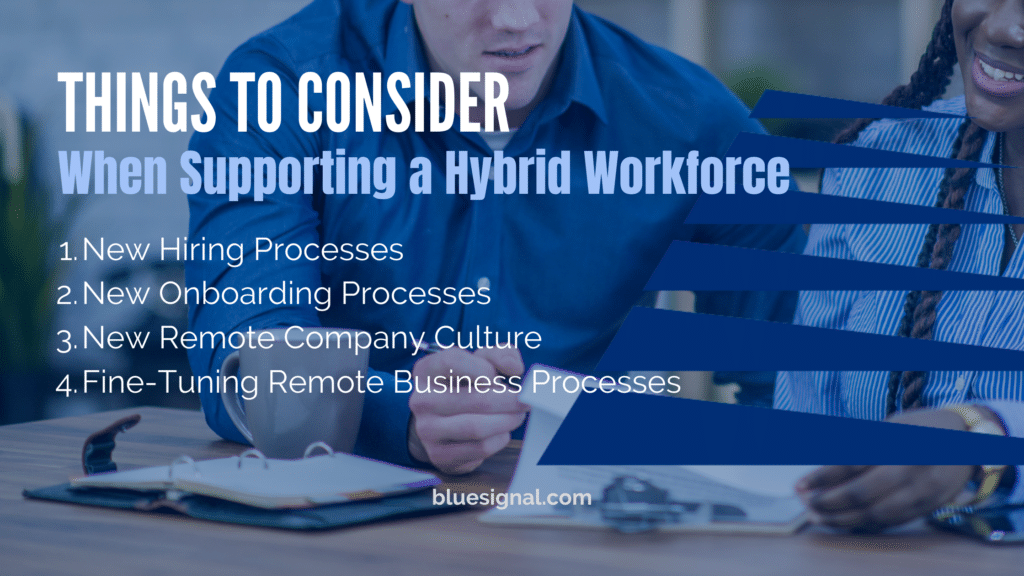Karli Larson is Blue Signal’s own employee engagement guru. As our Director of People and Culture, Karli helps BSS keep our own workforce engaged – with nearly 40 remote employees nationwide! Her initiatives have resulted in marked improvement in engagement as well as overall employee satisfaction. Karli’s expertise can easily be applied to any remote workforce. Watch her segment and read on to hear about some of her best practices!
“Whether your workforce was remote before the pandemic, they were forced to go remote, or they transitioned to remote indefinitely as a result of the pandemic, you may be wondering – how do I keep everyone engaged? Virtual happy hours have lost their luster and there is no longer an opportunity to connect by the water cooler or coffee machine, so what keeps people connected when they’re working remotely?”
Can Remote Employees be Fully Engaged?
“YES! And it doesn’t cost you a lot of money or time spent sipping White Claw at 4 o’clock in the afternoon in front of your computer screen. Recent studies have shown that remote employees who get regular feedback are the most engaged out of any other group, including in-person employees! They have the autonomy of working how and where they want to and they get meaningful feedback, creating optimal engagement.”
What Exactly do Remote Employees Need to be Engaged?
“Connection is the name of the game here. My top three suggestions for getting people engaged are:
#1 - Connection with their manager.
Employees want to know how they are performing and that someone cares about their success and well-being. This comes from regular one-on-ones. These one-on-ones can be every week, biweekly, or monthly depending on the needs of the employee, but they should be scheduled and there should definitely be an agenda. Gallup did a study that found that managers account for a 70% variance in employee engagement. So, no pressure managers, but you influence how your team feels about their job and the company.
#2 - Connection to their peers.
Human beings have an inherent desire to belong to a group. This sense of belonging helps them appreciate their work and not feel like they are going at it alone. Having regular team meetings creates a culture of shared values and open communication. Team meetings should focus on team goals that everyone’s striving for. They should also celebrate people's wins and offer assistance when people are dealing with work related hurdles.
#3 - Connection to the company.
Being connected to the company can look different for many people, but it starts before the offer is ever made. Maybe they align with your mission and values, they feel connected to the philanthropic endeavors of the company, or they’re just really excited about the company culture that they’re seeing online. Most of the time there is an attraction to your company, and you should find out what it is. During an interview, simply asking, “what drew you to our company?” will not only tell you about the level of research they did about your company, but it will also let you know what’s important to them.”
So Remote Employees Don’t Want Virtual Happy Hours?
“People want connection! So, after there has been a meaningful connection – i.e., the three things we just went over – find ways to bring people together. This may be mentorship programs, special groups, or even the occasional happy hour with games to learn about each other.”
Why is this Important?
“When you have high employee engagement, you have productive employees and better overall results – and that’s a win-win!”
Key Takeaways for Ensuring Engagement with your Remote Employees
When examining your engagement level among remote employees, it can be easy to miss some of the details. For instance, does your online presence align with your company’s values and goals? As a remote employer, how do you highlight your culture to job seekers? It’s important to make sure that your content represented both internally and externally to the worldwide web audience reflects the reasons why employees were excited to work for you to begin with. Make the mission of your remote engagement initiatives clear to everyone who sees your content. This way, you’ll attract candidates whose needs you are ready and able to meet. Furthermore, you’ll improve your retention by making those working for you today feel part of the bigger picture.
Karli covers several main points within her segment. Namely, that the tools to ensure engagement within your remote employees are simple, and free! With a good set of company values, the right communication, and dedicated leadership, remote employees will thrive when given the opportunity to connect.

Karli Larson
SR. MANAGER OF PEOPLE & CULTURE
Karli’s path to HR came from her two passions, people and service. She believes that HR is one of the single most human-based roles out there. By supporting the internal culture for the humans of Blue Signal, she is in turn helping humans from all industries succeed in their chosen careers!


